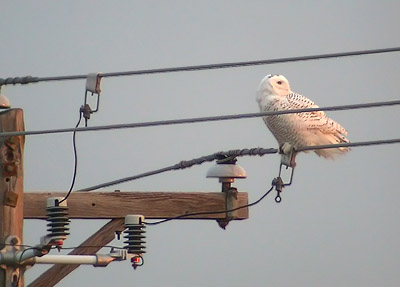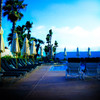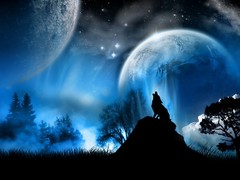
(taking a break on one of its favorite perches)
The increase in snowy owls may be due to a decrease in food in their home territory.
By Ron Seely - Wisconsin State Journal
An unusually high number of snowy owls - think of Hedwig the owl in Harry Potter - have taken up temporary residence in Wisconsin this winter.
With their white plumage and amber-colored eyes, the birds are striking. And they are mysterious, too, for how far they have traveled. Normally, they are at home on the tundra in the distant Arctic and some may even come from near the North Pole.
But they are here in surprising numbers this winter, perhaps for the same reason great gray owls visited last winter: a shortage of food in their far home territories.
Experts hesitate to label the presence of the birds an "irruption," the word used to describe an abrupt increase in an animal population because of problems such as foot shortages elsewhere.
Susan Foote-Martin, a conservation biologist with the Department of Natural Resources and an expert birder, said it isn't unusual to hear of a few snowy owls being spotted this far south in winter months. But she said that this year is indeed unusual for the bounty of snowys.
Karen Etter-Hale, executive secretary of the Madison Audubon Society, said by her count the birds have been spotted in at least 20 Wisconsin counties. She said it is difficult to estimate exactly how many of the birds might be in winter residence.
During a normal winter, according to "Wisconsin Birdlife" by the late Sam Robbins, between 12 and 15 of the owls will be identified in eight to 10 areas. Those numbers have been far exceeded this winter.
Etter-Hale said one Audubon member in Ashland reported as many as 35 of the owls being seen in or near that northern community.
"This is definitely a high year," said Etter-Hale.
At least three of the birds have been seen in Dane County, including two in the area of Audubon's Goose Pond Sanctuary near Arlington, east of Madison, and one in the area of Middleton's Pheasant Branch Conservancy. Another was spotted in Dodge County.
Snowy owls are spectacular party because they are the heaviest owls in North America and grow up to 23 inches tall with a wingspan of up to 52 inches.
Their heads look smooth and rounded, with no visible ear tufts such as those seen on the great horned owl, a more familiar species in these parts. Male snowy owls are almost entirely white, while females have dark bars crossing their wings and chests.
On the tundra, where they normally live, the owls eat mostly lemmings. Foote-Martin speculated that a large hatch of owls in the spring and possibly a dip in the population of lemmings may account for the large number of owls casting about so far south for food.
Like all owls, the snowys are adept hunters, relying on their keen hearing to pinpoint the location of prey. They are diurnal, meaning they hunt during the day and night. Here, they are eating mostly mice and voles.
So striking are the snowy owls that the birds have attracted crowds, which concerns some area birders. Waunakee birder Mike McDowell said the Pheasant Branch owl has actually caused minor traffic jams. He's taken to checking up on the birding jams to make sure the owl isn't being harmed.
McDowell urges respect for these special birds. He suggests staying in your car if you are viewing one of the snowy owls ands staying at least 50 feet from its perch. It's best to turn your car off because the birds rely heavily on sound when they hunt.
Why are humans so attracted to such creatures?
Etter-Hale said the face of an owl is ever-intriguing, partly because of its forward-facing eyes and partly for that intent and seemingly intelligent stare.
Foote-Martin said the snowy owl is a connection to all things wild. "It's fantastic," she said of the owls in our midst. "I'm never disappointed in nature."
Other Snowy Owl stories making the news:
Link: Arctic tourist on the wing - Oregon
Link: Snowy Owls lure Winter birders - Minnesota
Snowy Owl image © 2006 Mike McDowell

















